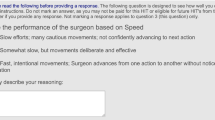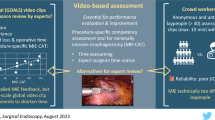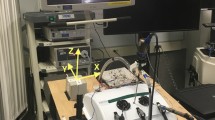Abstract
Purpose:
Finding effective methods of discriminating surgeon technical skill has proved a complex problem to solve computationally. Previous research has shown that obtaining non-expert crowd evaluations of surgical performances is as accurate as the gold standard, expert surgeon review. The aim of this research is: (1) to learn whether crowdsourced evaluators give higher ratings of technical skill to video of performances with increased playback speed, (2) its effect in discriminating skill levels, and (3) whether this increase is related to the evaluator consciously being aware that the video is manually manipulated.
Methods:
A set of ten peg transfer videos (five novices, five experts) were used to evaluate the perceived technical skill of the performers at each video playback speed used (\(0.4{\times }{-}3.6{\times }\)). Objective metrics used for measuring technical skill were also computed for comparison by manipulating the corresponding kinematic data of each performance. Two videos of an expert and novice performing dry laboratory laparoscopic trials of peg transfer tasks were used to obtain evaluations at each playback speed (\(0.2{\times }{-}3.0{\times }\)) of perception of whether a video is played at real-time playback speed or not.
Results:
We found that while both novices and experts had increased perceived technical skill as the video playback was increased, the amount of increase was significantly greater for experts. Each increase in the playback speed by \(0.4{\times }\) was associated with, on average, a 0.72-point increase in the GOALS score (95% CI 0.60–0.84 point increase; \(p < 0.001\)) for expert videos and only a 0.24-point increase in the GOALS score (95% CI 0.13–0.36 point increase; \(p < 0.001\)) for novice videos.
Conclusion:
Due to the differential increase in perceived technical skill due to increased playback speed for experts, the difference between novice and expert skill levels of surgical performances may be more easily discerned by manually increasing the video playback speed.








Similar content being viewed by others
References
Kowalewski T, Comstock B, Sweet R, Schaffhausen C, Menhadji A, Averch T, Box G, Brand T, Ferrandino M, Kaouk J, Knudsen B, Landman J, Lee B, Schwartz BF, McDougall E, Lendvay TS (2015) Crowd-sourced assessment of technical skills for validation of basic laparoscopic urologic skills (BLUS) tasks. J Urol 195(6):1859–1865
Makary M, Daniel M (2016) Medical error—the third leading cause of death in the US. BMJ 353:i2139
Birkmeyer JD, Finks JF, O’Reilly A, Oerline M, Carlin AM, Nunn AR, Dimick J, Banerjee M, Birkmeyer NJ (2013) Surgical skill and complication rates after bariatric surgery. N Engl J Med 369(15):1434–1442
Dockter R, Lendvay TS, Sweet RM, Kowalewski TM (2017) The minimally acceptable classification criterion for surgical skill: intent vectors and separability of raw motion data. Int J Comput Assist Radiol Surg 12:1151–1159
Chen C, White L, Kowalewski T, Aggarwal R, Lintott C, Comstock B, Kuksenok K, Aragon C, Holst D, Lendvay T (2013) Crowd-sourced assessment of technical skills: a novel method to evaluate surgical performance. J Surg Res 187(1):65–71
Vassiliou MC, Feldman LS, Andrew CG, Bergman S, Leffondre K, Stanbridge D, Fried GM (2005) A global assessment tool for evaluation of intraoperative laparoscopic skills. Am J Surg 190(1):107–113
Gumbs AA, Hogle NJ, Fowler DL (2007) Evaluation of resident laparoscopic performance using global operative assessment of laparoscopic skills. J Am Coll Surg 204(2):308–313
Kowalewski TM, White LW, Lendvay TS, Jiang IS, Sweet RS, Wright A, Hannaford B, Sinanan MN (2014) Beyond task time: automated measurements augments fundamentals of laparoscopic skills methodology. J Surg Res 192(2):329–338
Hung A, Chen J, Che Z, Nilanon T, Jarc A, Titus M, Oh PJ, Gill IS, Liu Y (2018) Utilizing machine learning and automated performance metrics to evaluate robot-assisted radical prostatectomy performance and predict outcomes. J Endourol 32(5):438–444
Barclay CD, Cutting JE, Kozlowski LT (1978) Temporal and spatial factors in gait perception that influence gender recognition. Percept Psychophys 23(2):145–152
Veto P, Einhauser W, Troje NF (2017) Biological motion distorts size perception. Sci Rep 7(42576):1–6
Jacobs A, Pinto J, Shiffrar M (2004) Experience context and the visual perception of human movement. J Exp Psychol 30(5):822–835
Seete RM, Beach R, Sainfort F, Gupta P, Reihsen T, Poniatowski LH, McDougall EM (2012) Introduction and validation of the american urological association basic laparoscopic urology surgery skills curriculum. J Endourol 26:190
Flash T, Hogan N (1985) The coordination of arm movements: an experimentally confirmed mathematical model. J Neurosci 5(7):1688–1703
Kowalewski TM, Seet R, Lendvay TS, Menhadji A, Averch T, Box G, Brand T, Ferrandino M, Kaouk J, Knudsen B, Landman J, Lee B, Schwartz BF, McDougall E (2016) Validation of the AUA BLUS tasks. J Urol 195:998
Bajcsy A, Losey DP, O‘Malley MK, Dragan AD (2018) Learning from physical human corrections, one feature at a time. In: Proceedings of 2018 ACM/IEEE international conference on human–robot interaction, NY, USA
Balasubramanian S, Melendez-Calderon A, Burdett E (2012) A robust and sensitive metric for quantifying movement smoothness. IEEE Trans Biomed Eng 59(8):2126–2136
Kowalewski TM (2012) Real-time quantitative assessment of surgical skill. Ph.D. thesis, University of Washington
Derossis AM, Fried GM, Abrahamowicz M, Sigman HH, Barkun JS, Meakins JL (1998) Development of a model for training and evaluation of laparoscopic skills. Am J Surg 175:482
Fried GM (2008) FLS assessment of competency using simulated laparoscopic tasks. J Gastroenterol Surg 12:210
Peters JH, Fried GM, Swanstrom LL, Soper NJ, Silin LF, Schirmer B, Hoffman K (2004) Development and validation of a comprehensive program of education and assessment of the basic fundamentals of laparoscopic surgery. Surgery 135:21
FFmpeg Developers (2016) ffmpeg tool (Version 4.1.3) (Software). http://ffmpeg.org/. Accessed 2 Oct 2019
Holoborodko P (2008) Smooth noise robust differentiators. http://www.holoborodko.com/pavel/numerical-methods/numerical-derivative/smooth-low-noise-differentiators/. Accessed 4 Oct 2019
Python Software Foundation. Python language reference, version 3.6. http://www.python.org. Accessed 4 Oct 2019
MATLAB R2019a, The Mathworks Inc. Natick, MA
Funding
This work was supported, in part, by the Office of the Assistant Secretary of Defense for Health Affairs under Award No. W81XWH-15-2-0030, the National Science Foundation CAREER Grant under Award No. 1847610, as well as the National Institutes of Health’s National Center for Advancing Translational Sciences, Grant UL1TR002494. Opinions, interpretations, conclusions, and recommendations are those of the authors and are not necessarily endorsed by the Department of Defense, the National Science Foundation, or the National Institutes of Healths’s National Center for Advancing Translational Sciences.
Author information
Authors and Affiliations
Corresponding author
Ethics declarations
Conflict of interest
The authors declare that they have no conflict of interest.
Ethical standard
All procedures performed in studies involving human participants were in accordance with the ethical standards of the institutional and/or national research committee and with the 1964 Helsinki declaration and its later amendments or comparable ethical standards.
Informed consent
Informed consent was obtained from all individual participants included in the study.
Additional information
Publisher's Note
Springer Nature remains neutral with regard to jurisdictional claims in published maps and institutional affiliations.
Rights and permissions
About this article
Cite this article
Kelly, J.D., Petersen, A., Lendvay, T.S. et al. The effect of video playback speed on surgeon technical skill perception. Int J CARS 15, 739–747 (2020). https://doi.org/10.1007/s11548-020-02134-x
Received:
Accepted:
Published:
Issue Date:
DOI: https://doi.org/10.1007/s11548-020-02134-x




